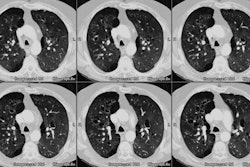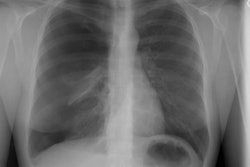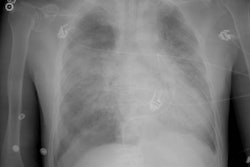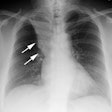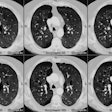Radiology 2001 Feb;218(2):533-9
Bronchiolitis obliterans syndrome in heart-lung transplant recipients:
diagnosis with expiratory CT.
Bankier AA, Van Muylem A, Knoop C, Estenne M, Gevenois PA.
PURPOSE: To determine the test performance and longitudinal evolution of air trapping for
diagnosing bronchiolitis obliterans syndrome (BOS). MATERIALS AND METHODS: Over 7 years,
111 combined inspiratory and expiratory computed tomographic examinations were performed
in eight healthy control subjects and 38 heart-lung transplant recipients. Functional
impairment was assessed with the BOS classification. Receiver operating characteristic
(ROC) analysis was performed to determine the optimal threshold of air trapping to
distinguish between patients with and those without BOS and to compute sensitivity and
specificity for diagnosing BOS. RESULTS: The extent of air trapping increased with BOS
severity (P =.001). A threshold of 32% of air trapping is optimal for distinguishing
between patients with and those without BOS and provides a sensitivity of 83%, a
specificity of 89%, and an accuracy of 88%. The prevalence of BOS and positive predictive
value of air trapping increased with postoperative time, but the negative predictive value
of air trapping remained high throughout the study. Patients without BOS who had air
trapping exceeding 32% of the parenchyma were at significantly increased risk of
developing BOS (P =.004). CONCLUSION: At the threshold of 32%, air trapping is sensitive,
specific, and accurate for diagnosing BOS. Patients with air trapping below 32% are
unlikely to have BOS. Air trapping exceeding 32% may be an early indicator of future BOS.
